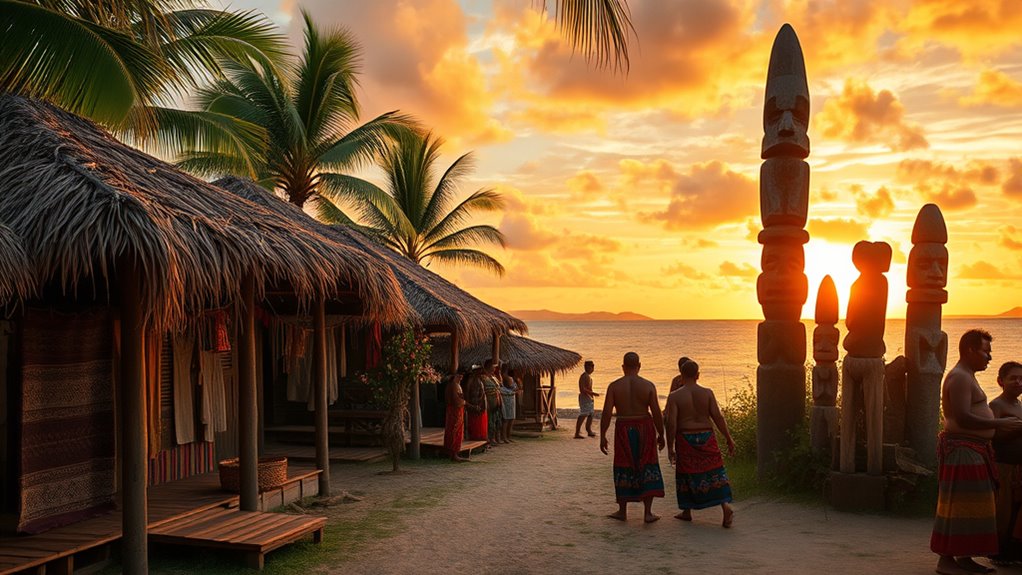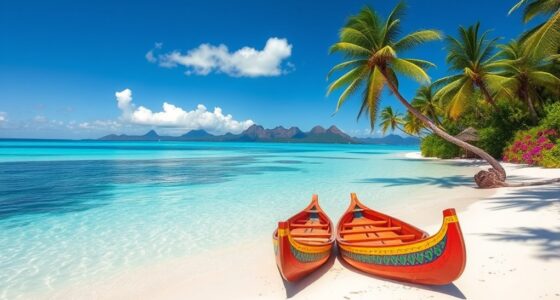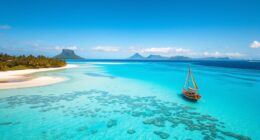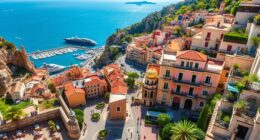Fiji’s history begins with volcanic islands formed 150 million years ago, inhabited by indigenous communities with rich traditions like storytelling, dance, and chiefly systems. Colonial periods introduced sugar plantations and Indian indentured laborers, creating a diverse society with Hindu and Islamic influences. Post-war political tensions led to coups and instability, shaping the nation’s modern identity. Today, Fiji balances indigenous customs with multicultural influences, managing ongoing political challenges. If you keep exploring, you’ll discover how this fascinating blend of history and culture continues to evolve.
Key Takeaways
- Fiji’s history is shaped by volcanic origins, early indigenous societies, and significant cultural traditions like oral storytelling and chiefdoms.
- The colonial period introduced sugar plantations and Indian indentured laborers, creating a multicultural society with diverse customs.
- Ethnic tensions between indigenous Fijians and Indo-Fijians have influenced political movements and independence struggles.
- Military coups from 1987 onward have caused political instability, impacting governance and social cohesion.
- Contemporary Fiji blends indigenous traditions with Indian cultural influences, facing ongoing challenges of political stability and cultural preservation.
Origins of Fiji’s Islands and Early Settlements
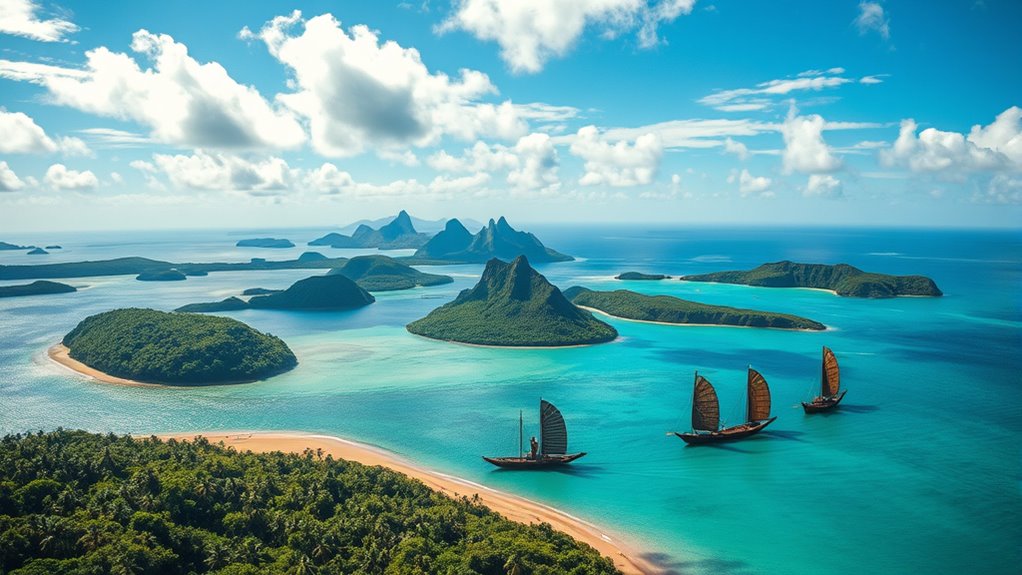
Fiji’s islands formed primarily from volcanic activity that started around 150 million years ago, shaping the archipelago we see today. You can still see evidence of this fiery origin in the rugged landscapes and volcanic peaks across the islands. Early settlers, the Lapita people, arrived around 1300 BC, spreading through the Pacific and establishing complex societies. These ancestors of modern Fijians developed hierarchical chiefly systems and rich cultural traditions long before Europeans arrived. You’ll find that indigenous Fijian communities organized themselves around extended families and tribes, linked to land through oral history and customs. The volcanic foundations and early settlements laid the groundwork for Fiji’s diverse cultural fabric, blending natural history with human resilience. Additionally, understanding the region’s diverse cultural traditions can offer deeper insights into how history and environment shape societies.
Colonial Era and the Rise of Sugar Economy

During the colonial period, the British established a plantation economy centered on sugar, transforming Fiji’s social and economic landscape. They introduced large-scale sugar plantations, which became the backbone of Fiji’s economy, attracting indentured laborers from India to work the fields. You’ll find that the sugar industry created a new social hierarchy, with plantation owners and managers at the top, while workers endured difficult conditions. The colonial government supported this system through investments and policies that prioritized sugar exports. This economic shift led to significant demographic changes, especially with the Indian community’s growth, shaping Fiji’s multicultural society. The rise of sugar also increased Fiji’s integration into global markets, making the economy heavily dependent on the plantation system and export revenues. Credit Card Processing & ISOs also played a role in facilitating international trade and financial transactions during this period.
The Impact of Indian Indentured Labor and Demographic Changes

The expansion of the sugar industry under colonial rule brought a significant influx of indentured laborers from India, which drastically reshaped Fiji’s demographic makeup. You’ll notice that this migration created a large Indo-Fijian community, now representing nearly half of the population. These laborers worked on sugar plantations, often facing poor conditions and limited rights. Their presence introduced Indian cultural elements, including Hindu and Islamic religious practices, cuisine, and festivals, which blend into Fiji’s diverse society. Demographic changes also affected land distribution and social dynamics, creating ethnic divisions that persist today. The arrival of Indian indentured workers altered Fiji’s cultural landscape, fostering a unique multicultural identity. This shift laid the foundation for ongoing ethnic tensions and political struggles, shaping Fiji’s social fabric well into modern times. Additionally, the integration of these communities has contributed to Fiji’s vibrant cultural festivals and culinary diversity, reflecting a multicultural society that continues to evolve.
Post-War Political Movements and Ethnic Tensions
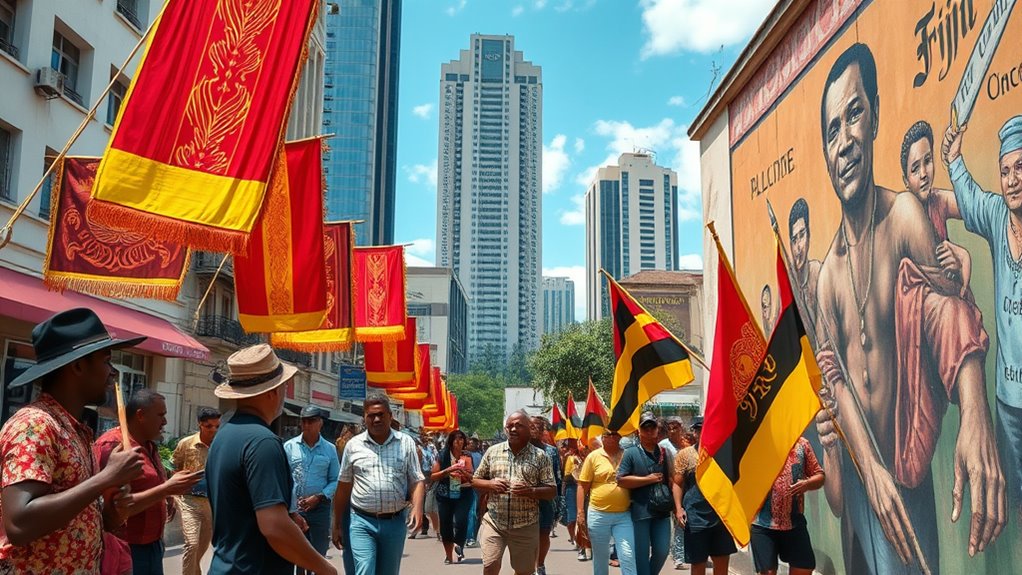
You see that after World War II, ethnic divisions in Fiji grew more pronounced, fueling political struggles over land and power. These tensions led to military coups aimed at safeguarding indigenous Fijian interests, often sidelining Indo-Fijians. As a result, Fiji’s political landscape became shaped by ongoing conflicts between ethnic groups and the fight for control over land and authority. The influence of ethnic tensions has been a persistent challenge in shaping Fiji’s modern political environment.
Ethnic Political Divisions
Post-World War II Fiji experienced deepening ethnic divisions that considerably shaped its political landscape. You can picture the growing tensions as indigenous Fijians wanted to protect their land and traditions, while Indo-Fijians fought for equal rights and land ownership. These divisions fueled political rivalry and instability, often manifesting in protests and discriminatory policies. The introduction of the Legislative Council in 1953 highlighted the ongoing ethnic divide, with separate roles for each community. When Fiji gained independence in 1970, ethnic loyalties remained strong, influencing leadership choices. You might imagine:
- Indigenous Fijians asserting land and chiefly authority
- Indo-Fijians seeking political representation and land rights
- Ethnic tensions erupting during elections
- Different cultural practices shaping political debates
These divisions kept Fiji politically fragile, fueling unrest and shaping its modern history. Understanding the complexities of these divisions helps explain the ongoing challenges faced by Fiji today.
Military Coups Impact
Military coups in Fiji have dramatically reshaped its political landscape by disrupting democratic processes and intensifying ethnic tensions. These actions often stem from fears of losing indigenous Fijian dominance, leading to instability. The 1987 coups, led by Rabuka, aimed to preserve Fijian supremacy, sidelining Indo-Fijians and fueling mistrust. The 2000 and 2006 coups further deepened divisions, disrupting governance and international relations. These upheavals weaken democratic institutions and foster ongoing resentment. Below is a table illustrating the key impacts:
| Impact on Fiji’s Society | Consequences |
|---|---|
| Political instability | Frequent changes in government |
| Ethnic tensions | Increased inter-group conflicts |
| International relations | Strained diplomatic ties |
| Economic disruption | Decline in tourism and trade |
| Democratic setbacks | Reduced public trust in government |
Additionally, these military interventions have often been justified by leaders as necessary to restore order, but they ultimately undermine long-term stability and democratic development.
Land and Power Struggles
Land and power struggles have been at the heart of Fiji’s ongoing political conflicts since independence. You witness how indigenous Fijians fiercely guard their land, viewing it as central to their identity and chiefly authority. Meanwhile, Indo-Fijians push for greater land rights and political influence, fueling ethnic tensions. These disputes often lead to unrest, coups, and constitutional crises. The cycle of unresolved issues and recurring conflicts can be seen as part of the broader relationships dynamic that influences Fiji’s political landscape. You can imagine:
- Chiefs and government officials clashing over land ownership and control
- Ethnic communities rallying around traditional land claims and cultural pride
- Military interventions justified by the need to protect Fijian interests
- Displacement of families caught in land disputes, deepening divisions and mistrust
These struggles shape Fiji’s political landscape, highlighting the persistent challenge of balancing land rights, ethnic identity, and power.
Military Coups and Political Instability

Fiji’s political landscape has been deeply affected by a series of military coups, which have often disrupted democratic processes and fueled ethnic tensions. In 1987, Colonel Sitiveni Rabuka led two coups aimed at securing indigenous Fijian dominance, sidelining Indo-Fijians and creating lasting divisions. These upheavals led to Fiji’s temporary suspension from the Commonwealth and increased instability. In 2006, Commodore Frank Bainimarama ousted the government, citing the need to restore order and restructure politics. His intervention sidelined elected leaders and delayed democratic progress. These coups have weakened institutions, undermined trust in governance, and complicated efforts to build national unity. Military interventions continue to shape Fiji’s politics, leaving a legacy of instability that the nation still endeavors to overcome.
Indigenous Cultural Traditions and Social Structures

Indigenous Fijian culture centers on strong communal bonds, with social structures built around chiefly authority and extended family networks. You’ll notice that chiefs hold significant influence, guiding community decisions and rituals. Family ties extend beyond immediate relatives, forming clans—known as mataqali—that share land and resources. Ceremonies like yaqona (kava) rituals reinforce social hierarchy and unity. Oral storytelling preserves history and teaches values, often performed during gatherings. Dance and music are essential expressions of identity, showcasing cultural stories and celebrations. Respect for elders and traditional customs remains core, shaping daily life. You can imagine vibrant ceremonies, communal land ownership, and an enduring sense of belonging rooted in these ancient traditions. Additionally, the integration of traditional rituals with contemporary life illustrates the resilience of indigenous cultural practices.
Fusion of Indigenous and Indian Cultural Influences
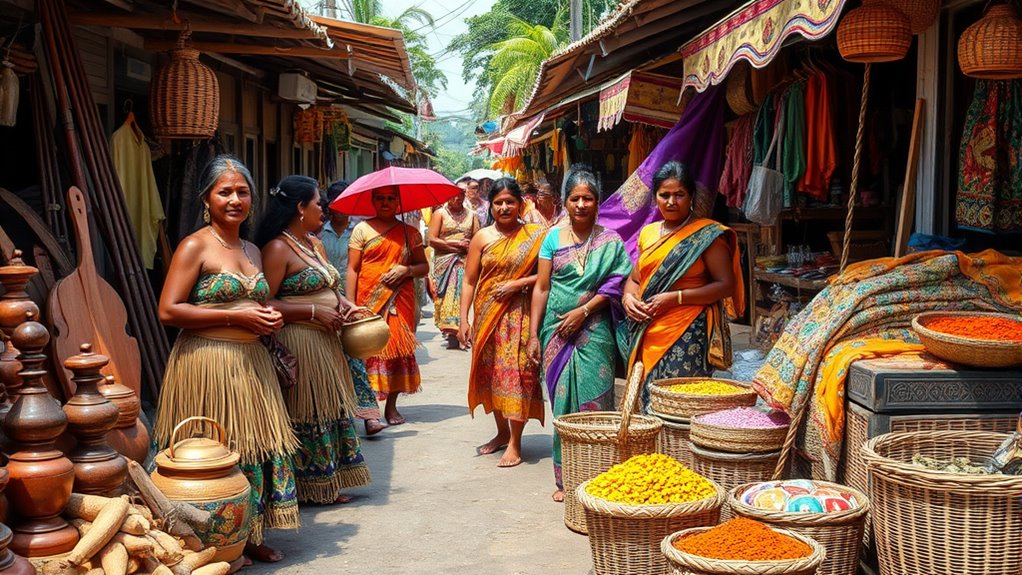
The rich cultural landscape of Fiji reflects a dynamic blend of its native traditions and the influences brought by Indian indentured laborers. You’ll notice this fusion in everyday life, from vibrant festivals to culinary delights. Indo-Fijian communities brought their Hinduism, Islam, and unique music styles, which now coexist with indigenous practices. You might see traditional Fijian dances alongside Indian classical performances during celebrations. The cuisine combines Fijian seafood with Indian spices, creating flavorful dishes like curry and roti. Clothing also reflects this mix, with saris and dhotis worn alongside traditional Fijian attire. Over time, both cultures have influenced language, social norms, and community rituals, fostering a multicultural identity that defines modern Fiji. This blending strengthens the nation’s unique and diverse heritage. Additionally, the cultural exchange has led to the development of hybrid art forms and festivals that celebrate both traditions.

Exploring modern Fiji’s identity and governance involves balancing its rich cultural diversity with the challenges of political stability. You see a nation where indigenous Fijians, Indo-Fijians, and Europeans coexist, yet tensions remain. Political upheavals, including military coups, have disrupted democratic progress, forcing leaders to navigate ethnic interests carefully. Efforts to foster unity often clash with deep-rooted land disputes and competing visions of governance. You witness a society endeavoring to reconcile tradition with modern democracy, all while maintaining regional influence. Unique and Wicked Planters are often used in community projects to promote cultural heritage and environmental sustainability. Lush villages with traditional ceremonies blending into urban centers, military tanks parked near parliamentary buildings amid protests, ethnic festivals showcasing indigenous dances alongside Indian rituals, and political rallies echoing calls for unity amid division.
Frequently Asked Questions
How Did Fiji’s Indigenous Society Evolve Before European Contact?
Before European contact, Fiji’s indigenous society evolved into complex tribal systems with hierarchical chiefly structures. You’d see communities organized around extended families and clans, called mataqali, which held land collectively. Cultural practices emphasized communal living, elaborate ceremonies like yaqona rituals, and oral storytelling to preserve history. Social roles were clearly defined, fostering strong ties within communities. This structured society helped maintain order and cultural identity long before outside influences arrived.
What Role Did Christianity Play in Shaping Modern Fijian Culture?
Christianity influences over 80% of Fiji’s population today, shaping social norms and festivals. You’ll notice Christian practices integrated into daily life, from church services to community celebrations. It promotes values like charity and community support, blending with indigenous traditions. You might also see Christian symbols in public spaces and hear gospel music at events, reflecting its essential role in fostering social cohesion and shaping modern Fijian identity.
How Do Land Rights Influence Fiji’s Political and Ethnic Relations Today?
Land rights critically influence Fiji’s political and ethnic relations today. You’ll find that indigenous Fijians prioritize land ownership, viewing it as essential to their culture and identity, which often leads to resistance against land sales or redistribution. Indo-Fijians’ limited access to land fosters economic disparities and political tension, fueling ongoing debates about land policies. This ongoing struggle for land rights maintains ethnic divisions and impacts national unity and governance.
What Are the Main Traditions Preserved Through Fijian Dance and Storytelling?
You can see that Fijian dance and storytelling preserve traditions like communal living, chiefly authority, and elaborate ceremonies such as yaqona (kava) rituals. These practices celebrate social bonds, honor ancestors, and pass down history orally. You’ll notice dance movements and songs that reflect cultural values, while storytelling keeps legends alive. These traditions strengthen community ties and help maintain Fijian identity across generations.
How Have Recent Political Reforms Affected Fiji’s Ethnic Harmony?
Recent political reforms in Fiji aim to improve ethnic harmony by promoting inclusive governance and reducing tensions. You might notice efforts to guarantee fair representation of both indigenous Fijians and Indo-Fijians in leadership roles. These changes encourage dialogue and cooperation, helping to rebuild trust across communities. While challenges remain, such reforms are essential for fostering unity, stability, and a shared national identity in Fiji’s diverse society.
Conclusion
Just as Odysseus navigated treacherous waters, Fiji’s journey reflects resilience amid shifting currents. Your understanding of its rich history reveals a tapestry woven from ancient traditions, colonial echoes, and modern struggles. Embrace this vibrant mosaic, knowing that, like a phoenix rising from ashes, Fiji continues to forge its identity through unity and change. Its story reminds us that even in chaos, hope and transformation endure—guiding it toward a future shaped by both past and promise.

